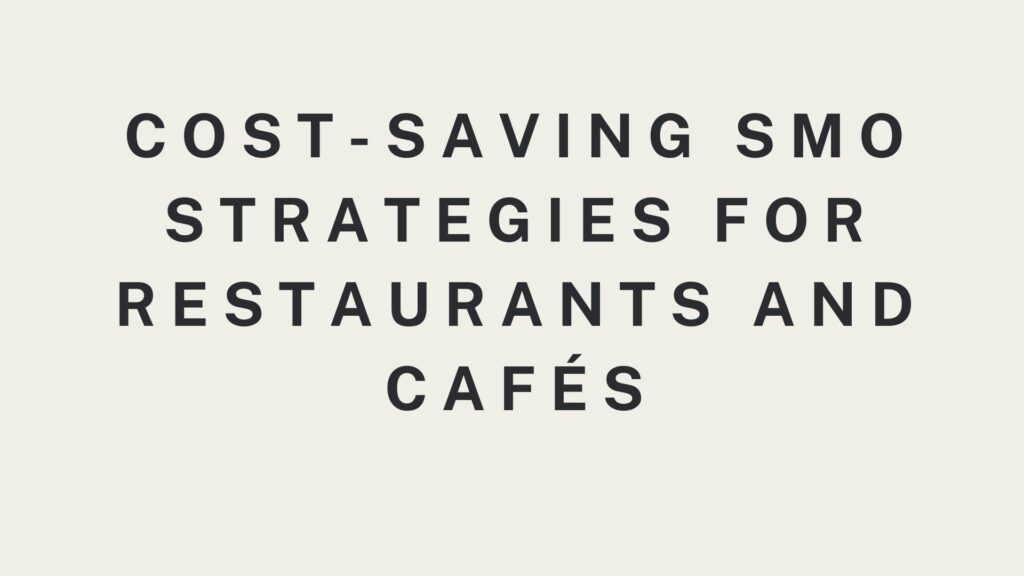Cost-Saving SMO Strategies for Restaurants and Cafés

Introduction to Social Media Optimization for Restaurants and Cafés
In today’s digital age, social media has become an essential tool for businesses of all types, including restaurants and cafés. With the increasing number of people relying on social media platforms to discover new dining experiences, it’s crucial for restaurant and café owners to leverage social media optimization (SMO) strategies. Effective SMO can help attract new customers, engage existing ones, and ultimately boost your business’s bottom line—all while being cost-effective.
Why SMO is Important for Restaurants and Cafés
Building a Strong Online Presence
For restaurants and cafés, having a strong online presence is vital. Potential customers often turn to social media to find information about where to eat, read reviews, and view menus. By optimizing your social media profiles, you can ensure that your business stands out in a crowded market. This visibility not only attracts more followers but also drives foot traffic to your physical location.
Engaging with Your Audience
Social media allows restaurants and cafés to engage directly with their audience. Whether it’s responding to comments, sharing behind-the-scenes content, or promoting special events, these interactions help build a loyal customer base. Engaging with your audience fosters a sense of community and encourages repeat visits.
Cost-Effective Marketing
Unlike traditional advertising methods, social media marketing is relatively inexpensive. With the right strategies, you can achieve significant results without breaking the bank. This makes SMO an ideal choice for small to medium-sized restaurants and cafés looking to maximize their marketing budget.
Setting Up Your Social Media Profiles
Choose the Right Platforms
Not all social media platforms are created equal, and it’s essential to choose the ones that align with your target audience. For restaurants and cafés, visual platforms like Instagram and Facebook are ideal for showcasing food and ambiance. Twitter can be used for quick updates and customer interactions, while Pinterest is great for sharing recipes and food ideas.
Optimize Profile Information
Your social media profiles should be complete and up-to-date. This includes your business name, address, phone number, and website link. Make sure your profile picture and cover photo are professional and reflective of your brand. Use keywords related to your restaurant or café in your bio to improve searchability.
Consistent Branding
Consistency in branding across all social media platforms is crucial. Use the same logo, color scheme, and tone of voice to create a cohesive brand identity. This consistency helps customers recognize your brand easily, whether they find you on Instagram, Facebook, or any other platform.
Content Creation for Social Media
High-Quality Visual Content
For restaurants and cafés, high-quality images and videos are essential. Visual content is more likely to be shared, liked, and commented on, increasing your reach. Invest in good lighting and photography to make your dishes look as appetizing as possible. Consider posting videos that showcase your chefs at work, customer testimonials, or special events.
Storytelling Through Posts
People love stories, and social media is the perfect platform to share the story of your restaurant or café. Whether it’s the inspiration behind your menu, the history of your establishment, or the journey of sourcing local ingredients, storytelling helps create an emotional connection with your audience.
User-Generated Content
Encourage your customers to share their dining experiences on social media. User-generated content (UGC) is not only free but also acts as a testimonial for your business. Reposting UGC on your profiles can increase engagement and show appreciation to your customers.
Regular Posting Schedule
Consistency is key in social media marketing. Create a posting schedule that ensures you are regularly updating your profiles with fresh content. Whether it’s daily, bi-weekly, or weekly, maintaining a consistent presence keeps your audience engaged and interested.
Engaging Your Audience
Responding to Comments and Messages
Engagement is a two-way street. Make sure to respond to comments and messages promptly. Acknowledging your audience’s feedback, whether positive or negative, shows that you value their opinions. This interaction can turn first-time visitors into loyal customers.
Hosting Contests and Giveaways
Contests and giveaways are a fun way to increase engagement on your social media profiles. Encourage your followers to participate by offering a free meal, discount, or other incentives. This not only boosts your online presence but also brings more customers through your doors.
Utilizing Polls and Surveys
Polls and surveys are effective tools for gathering feedback from your audience. You can ask questions about menu preferences, favorite dishes, or suggestions for improvement. This not only makes your audience feel involved but also provides valuable insights for your business.
Promoting Special Events and Offers
Creating Event Pages
If your restaurant or café is hosting a special event, such as a wine tasting or live music night, create an event page on platforms like Facebook. Event pages allow you to share all the details in one place and make it easy for customers to RSVP. Promote the event through your regular posts and encourage your followers to share it with their friends.
Sharing Limited-Time Offers
Social media is an excellent platform for promoting limited-time offers or seasonal menus. Create eye-catching graphics and use countdowns to create a sense of urgency. Sharing these offers on your stories and main feed can drive traffic to your restaurant or café during slower periods.
Collaborating with Influencers
Influencer marketing can be a powerful tool for promoting your restaurant or café. Partner with local influencers who have a strong following in your area. They can help spread the word about your business through posts, stories, and reviews. Make sure to choose influencers whose values align with your brand for authentic promotion.
Measuring Success and Adjusting Strategies
Analyzing Social Media Metrics
To understand the effectiveness of your SMO strategies, it’s essential to analyze social media metrics regularly. Platforms like Facebook, Instagram, and Twitter offer insights into post performance, audience demographics, and engagement rates. Use this data to determine what’s working and what needs improvement.
Adjusting Content Based on Performance
If certain types of content are performing better than others, adjust your strategy accordingly. For example, if your audience engages more with videos than photos, consider incorporating more video content into your schedule. Flexibility and adaptability are key to a successful SMO strategy.
Tracking Return on Investment (ROI)
While SMO is generally cost-effective, it’s still important to track your ROI. Compare the amount of time and money invested in social media marketing with the revenue generated from increased customer visits or online orders. This will help you identify the most profitable strategies and refine your approach.
Affordable Tools for SMO
Social Media Management Tools
There are several affordable tools available to help manage your social media profiles efficiently. Tools like Hootsuite, Buffer, and Later allow you to schedule posts, track engagement, and analyze performance—all in one place. These tools save time and make it easier to maintain a consistent online presence.
Graphic Design Tools
High-quality visuals are essential for SMO, but hiring a professional designer can be costly. Fortunately, tools like Canva and Adobe Spark offer affordable options for creating stunning graphics. These platforms provide templates and easy-to-use features that make it simple for anyone to design professional-looking content.
Analytics Tools
To measure the success of your SMO efforts, analytics tools like Google Analytics and Facebook Insights are invaluable. These tools provide detailed reports on traffic, engagement, and audience behavior, allowing you to make data-driven decisions. Many of these tools offer free versions or affordable plans for small businesses.
Tips for Cost-Saving SMO
Focus on Organic Reach
While paid advertising on social media can be effective, focusing on organic reach is a cost-saving strategy. Optimize your posts for maximum engagement by using relevant hashtags, posting at peak times, and encouraging shares. Building a strong organic following takes time but pays off in the long run.
Leverage Free Resources
Many social media platforms offer free resources and tools to help businesses grow. Take advantage of Facebook’s Business Suite, Instagram’s business tools, and Twitter’s analytics features. These resources provide valuable insights and can help you optimize your SMO strategy without additional costs.
Cross-Promote on Different Platforms
Cross-promotion is a simple yet effective way to extend your reach without spending extra money. Share your Instagram posts on Facebook, tweet about your latest Facebook event, or include a Pinterest link in your Instagram bio. This strategy ensures that your content reaches a broader audience across multiple platforms.
Collaborate with Other Local Businesses
Partnering with other local businesses for cross-promotion can be mutually beneficial and cost-effective. For example, a café could collaborate with a nearby bakery to promote each other’s products on social media. This type of collaboration increases visibility for both businesses without additional marketing costs.
Conclusion
Implementing cost-saving SMO strategies can significantly benefit restaurants and cafés, helping them attract more customers, engage with their audience, and boost their online presence—all while staying within budget. By choosing the right platforms, creating compelling content, engaging with followers, and leveraging affordable tools, your restaurant or café can thrive in the competitive world of social media marketing. As you refine your approach, consider exploring affordable smo services to further enhance your strategy without overspending.
FAQs:
1. Why is Social Media Optimization (SMO) important for restaurants and cafés?
Social Media Optimization (SMO) is crucial for restaurants and cafés because it helps build a strong online presence, engage with customers, and promote special offers and events. Effective SMO strategies can attract new customers, retain existing ones, and increase foot traffic to your establishment, all while being cost-effective.
2. What are some cost-saving SMO strategies that can benefit my restaurant or café?
Some cost-saving SMO strategies include focusing on organic reach, using free social media tools, creating high-quality visual content, and cross-promoting on different platforms. Additionally, collaborating with other local businesses and leveraging user-generated content can help you optimize your social media efforts without spending a lot of money.
3. How can I measure the success of my SMO strategies?
You can measure the success of your SMO strategies by analyzing social media metrics such as engagement rates, post performance, and audience demographics. Tools like Google Analytics and Facebook Insights can help track your progress. Regularly reviewing these metrics will allow you to adjust your content and strategies to maximize your return on investment (ROI).





